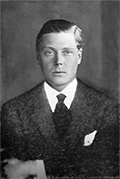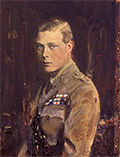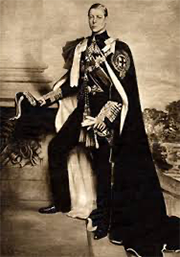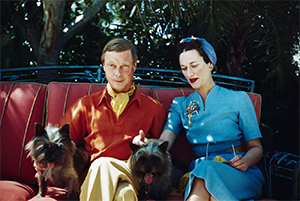King Edward VIII of the United Kingdom
Edward VIII was King of the United Kingdom for most of a year in the first half of the 20th Century. He is most well-known for giving up the throne in order to get married. 
He was born on June 23, 1894 in Richmond, Surrey. He was the first child born to the future reigning monarch, King George V, who was then Duke of York, and his wife, Mary. The monarch on the throne at the time of Edward's birth was his great-grandmother, Queen Victoria. The Duke of York was quite strict with his oldest son, who chafed under the pressure. Edward studied under a private tutor for several years. When he was 12, his parents sent him to the Naval College at Osborne. Two years later, he went to Dartmouth, to the Royal Naval College there. He finished up his studies at Magdalen College, Oxford. In 1910, King Edward VII, who had succeeded Victoria in 1901, died, elevating George, the Duke of York, to the kingship and young Edward to be Prince of Wales, the heir to the throne. 
Edward volunteered to serve as a soldier in the Grenadier Guards during World War I. He was not granted a battlefield commission because the high command did not want to risk his being captured and held as a prisoner at high ransom. He was sent to "safe" positions in Italy and visited the front several times. After the war, he toured many parts of the British Empire on behalf of his father and gained in popularity and prominence. He was handsome and had not married and was considered a very eligible bachelor. He certainly enjoyed the company of rich and/or high-profile women, and he especially enjoyed being around married women. It was to one of those women that he was introduced in 1931. She was Wallis Simpson, and her husband was Ernest Simpson, a British-American businessman. Ernest was Wallis's second husband; she had divorced her first, Win Spencer, in 1927. Edward and Wallis found that they liked each other very much and spent a considerable amount of time together in the next few years. 
King George V died on Jan. 20, 1936, and Edward became king. He was popular with the people, both in the United Kingdom and abroad, but he was also unorthodox in his approach to many things. This extended to his kingship, as he set out to change many things about the monarchy, some significantly. He worried about finances and cut salaries of many of the royal staff. At the same time, he kept state papers for weeks and then sometimes returned them unexamined, causing consternation with governmental leaders. Security officials also discovered that the king did not always keep such papers in a safe location. It was a dark time for many people in Europe during the 1930s, and spies were seemingly everywhere. He also was late for appointments or canceled them at the last minute, again annoying those in government who needed his approval for things. Another seemingly innocuous thing that he did was order the normalization of the Sandringham clocks, which had been set ahead 30 minutes by his grandfather in order to maximize hunting time. In October 1936, Ernest and Wallis Simpson divorced. King Edward soon made it known that he wanted to marry Wallis. Many people in the U.K., inside government and out, voiced their displeasure at the king's marrying a divorced woman. Some of those who were counseling Edward not to do so held positions at the highest level of government. The king made it clear that he would pursue a marriage to the woman he loved and, as a compromise, proposed that his new wife be granted no property or rank or anything that would normally be accorded to the spouse of a monarch. Prime Minister Stanley Baldwin and the rest of the Cabinet refused to accept such an arrangement, saying that the king was the head of the Church of England, which opposed remarriage after divorce, and that it was the duty of the king to uphold the policies of the Church. Baldwin also said that if the king stayed on the throne and married the woman he wanted to, then the entire Cabinet, including Baldwin, would resign. Edward was faced with a choice: He could remain king, or he could marry Wallis. He chose the latter, renouncing his claim to the throne on Dec. 10, 1936. As part of his speech announcing his abdication, he said, "I have found it impossible to carry the heavy burden of responsibility and to discharge my duties as king as I would wish to do without the help and support of the woman I love." His brother became King George VI. Edward, who had been named Duke of Windsor, and Wallis were married on June 3, 1937, in France. They lived in that country for a few years, during which Edward met with Adolf Hitler and other Nazi officials. He also gave a speech in 1939 that was widely interpreted as supporting the appeasement of Germany and its territorial aims, a policy that the U.K. government was clearly not pursuing. When Germany overran France in 1940, Edward and Wallis went to live in Spain. They became the target of a Nazi plot, one that very nearly succeeded. The Germans planned to kidnap Edward and then put him back on the U.K. throne but under their sway. Prime Minister Winston Churchill, who might have suspected something of the kind but was certainly aware that Edward was willing to overlook some of the atrocities being committed by German officials, named Edward the Governor of the Bahamas and arranged his transport to the West Indies territory. Edward and Wallis left Europe on Aug. 1, 1940. A German security team very nearly caught them. 
Edward remained in the Bahamas in an official capacity for five years. He and Wallis moved back to France in 1945 but visited the U.K. sparingly. He was on hand for the funerals of his mother and King George VI. At other times, other members of the royal family made it plain that Edward and Wallis were not welcome. They found more of a welcome in the United States, visiting both President Dwight D. Eisenhower and later Richard Nixon at the White House. He wrote a number of books in the 1950s: a memoir titled A King's Story, an examination of the royal family's fashion and habits titled A Family Album, and a quasi-historical treatise titled The Crown and the People, 1902–1953. Edward VIII never held another royal post. He suffered from ill health in his last years, culminating with the contraction of throat cancer. He died in Paris on May 28, 1972. His body was returned to the U.K., where he lay in state and was buried in the Royal Burial Ground. Lying beside him is his wife, who died 14 years later. |
|
Social Studies for Kids
copyright 2002–2026
David White




